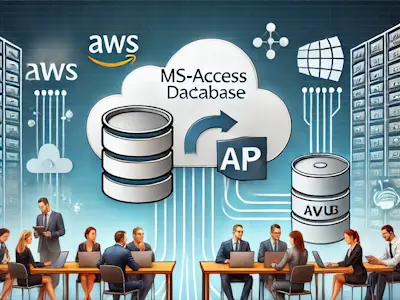Seneste nyt
 16. marts 2025
16. marts 2025As businesses continue to evolve, so should your technology. If your company is still relying on an MS-Access database, now is the time to upgrade. With Antrow Software, you can seamlessly convert MS-Access into a Web App and run it in the cloud for enhanced efficiency, accessibility, and security.
? Access Your Data Anywhere, Anytime – Work from any device without limitations.
? Run MS-Access in the Cloud – Eliminate server dependency and reduce IT maintenance costs.
? Scalability & Security – Protect your data while ensuring your system grows with your business.
? Seamless Migration – Our team ensures a smooth transition with minimal downtime.
Migrating to a cloud-based Web App is not just about modernization—it’s about staying ahead of the competition and ensuring your business is future-ready.
?? Contact us today to discuss how Antrow Software can help you upgrade your MS-Access system into a high-performance Web App running on AWS, Azure, or your preferred cloud provider.
?? Learn more: antrow.com
Best regards,
The Antrow Software Team
#MSAccessToWebApp #RunMSAccessInTheCloud #CloudMigration #BusinessEfficiency #AntrowSoftware

Kundehistorier
 27. februar 2023Forfatter: Antrow Software
27. februar 2023Forfatter: Antrow SoftwareJohn er ejer af en lille produktionsvirksomhed, som har brugt Microsoft Access som deres primære databaseadministrationssystem i mange år. Systemet er imidlertid blevet forældet, svært at administrere og mangler de nødvendige funktioner til at følge med virksomhedens vækst. John ved, at han er nødt til at modernisere systemet for at forbedre effektiviteten, produktiviteten og rentabiliteten.
Efter at have foretaget omfattende research støder John på Antrow.com og opdager, at de specialiserer sig i at konvertere Microsoft Access-databaser til moderne, cloud-baserede webapplikationer. John beslutter sig for at kontakte Antrow.com for at få mere at vide om deres tjenester.
Efter at have kontaktet Antrow.com får John tildelt en dedikeret projektleder, som arbejder tæt sammen med ham for at forstå virksomhedens specifikke behov og krav. Projektlederen evaluerer den eksisterende Microsoft Access-database, foreslår en skræddersyet løsning og giver en detaljeret projektplan og tidslinje.
Antrow.com's team af erfarne udviklere begynder derefter at arbejde på projektet og konverterer Microsoft Access-databasen til en moderne, cloud-baseret webapplikation. Den nye applikation er sikker, skalerbar og brugervenlig og har robuste funktioner og funktioner, der opfylder virksomhedens specifikke behov.
Efter projektet er afsluttet, giver Antrow.com John omfattende uddannelse i brugen af det nye system og løbende support og vedligeholdelse for at sikre, at systemet fortsat opfylder virksomhedens behov.
Takket være Antrow.com's MS-Access to Web App Conversion service har Johns produktionsvirksomhed nu et moderne, effektivt og produktivt databaseadministrationssystem, der gør det muligt for dem at følge med deres vækst og opnå større succes.

Seneste artikler
 14. maj 2023Forfatter: Antrow Software
14. maj 2023Forfatter: Antrow SoftwareAPI'er (Application Programming Interfaces) er en samling værktøjer, som Google stiller til rådighed for udviklere, så de kan få adgang til data fra forskellige Google-tjenester, herunder Google Maps, YouTube, Gmail og meget mere. Webapplikationer, mobilapplikationer og andre softwareprojekter kan omfatte disse API'er.
Anvendelse af Google Web API'er har flere fordele. De giver først og fremmest et væld af data og funktioner, der kan forbedre den måde, som brugerne interagerer med din applikation på. Hvis du f.eks. tilføjer Google Maps API, kan du gøre det nemt for folk at få adgang til kort og vejledninger til deres valgte steder, hvis du opretter et rejsewebsted.
Enkelheden ved integration er en anden fordel. Google Web API'er leveres med grundig dokumentation og support, og de er designet til at være enkle at bruge. Det betyder, at programmører ikke behøver at bruge en masse tid på at lære vanskelige programmeringsmetoder for hurtigt og enkelt at integrere Google-tjenester i deres apps.
Derudover er Google Web API'er, afhængigt af tjenesten, nogle gange gratis eller meget billige at bruge. Derfor er de et økonomisk valg for udviklere, der ønsker at give deres apps betydelig funktionalitet uden at skulle betale mange penge.
Det faktum, at Google Web API'er er meget pålidelige og skalerbare, er en yderligere fordel. Fordi Google har en stærk infrastruktur til at understøtte sine tjenester, kan udviklere stole på, at disse API'er er tilgængelige og fungerer selv i tider med stor efterspørgsel.
Brug af Google Web API'er kan også hjælpe dit websteds søgemaskineoptimering (SEO). Den mest populære søgemaskine i verden, Google, har API'er, som du kan bruge til at sikre, at dit websted er forberedt til Googles søgealgoritmer.
Afslutningsvis kan man sige, at Google Web API'er giver programmører en stærk samling værktøjer, der kan forbedre brugervenligheden og effektiviteten af deres apps. De er enkle at bruge, rimeligt prissat, troværdige, og de kan hjælpe med SEO.